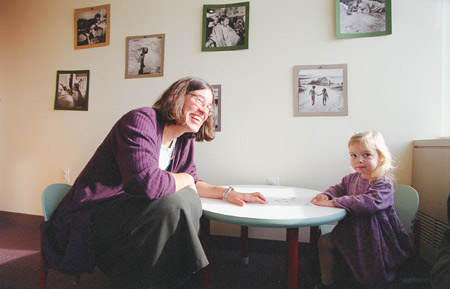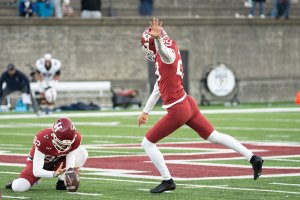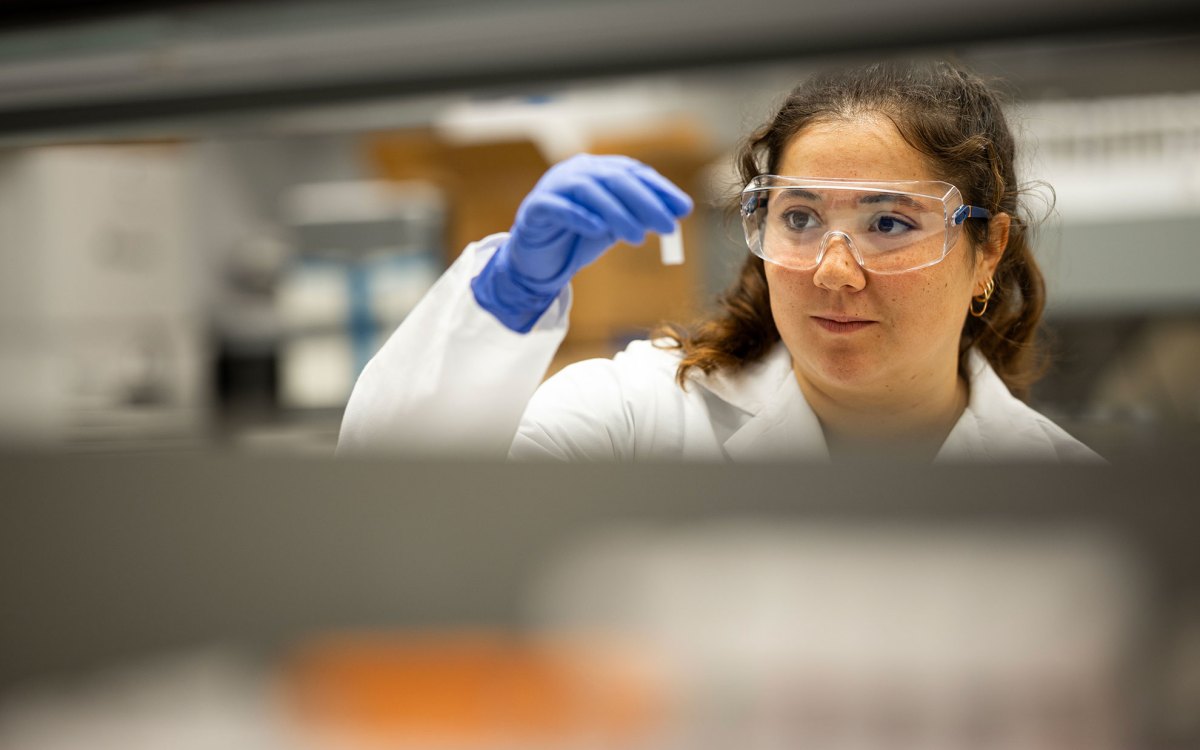Toddling toward the birth of knowledge
Psychologist Spelke focuses on how infants become acquainted with the world

Elizabeth Spelke was surprised to discover how much infants know about what’s going on around them. The newly tenured professor of psychology was just as surprised by their limits. In some situations, counting, for example, babies act more like monkeys, rats, or pigeons than humans.
Spelke, 52, was recently named by Time magazine as one of “America’s Best” in science and medicine, a list of “brilliant researchers who are the envy of the world.” Describing her work in a bright corner office of William James Hall, Spelke is more modest.
“I’m trying to find out what infants are aware of and how they think about the world around them,” she says. “Answers to such questions should help us understand the origins of human knowledge.”
Spelke focuses on how infants know what they know about numbers, about objects they see and hear, and how they get from one place to another. Yes, babies younger than a year old can do what some people call counting, but in a monkeylike way.
Psychologists once believed that infants remain unaware of objects they cannot see until they are about a year old. But experiments that Spelke and others have done reveal that babies only a few months old know when something is hidden behind a barrier.
In experiments done by her Harvard colleague, Susan Carey [profiled in the Nov. 8, 2001, Gazette], infants demonstrate what Spelke calls “the building blocks of arithmetic.” Show a baby an object, say a ball, then put it out of sight in a box. If you then add a second ball and ask the infant to retrieve the ball, the child will reach into the box twice, not once or more than twice.
The same thing happens if you hide a toy behind a screen, then add a second object. The infant reveals by its pattern of looking that it expects to see two, not one, things when the screen is removed.
“Both experiments support the conclusion that babies add one and one to form a representation of two objects,” Spelke points out.
Her research shows that babies can tell the difference between two sets of larger numbers of objects. For example, they distinguish between arrays of eight and 16 dots. The tots do this even when the sizes, positions, and brightness of the dots are changed, proving that they rely on numbers and not other properties of the dots.
If this ability surprises you, you should know that chimps, rats, and even pigeons can do the same thing.
Babies don’t count like adults
Using objects like a few bananas, Marc Hauser, a Harvard professor of psychology, has learned that adult monkeys can add and subtract as well as human infants, at least until the humans reach age 3 to 3 1/2 years. Then humans jump ahead because they develop the ability to talk.
Spelke and her colleagues were amazed to find that human infants use a completely different way to “count” small numbers before they start to use language.
When young children learn that numbers can be represented by symbols as well as by actual objects, their thinking shifts into another mental gear. They discover that eight and 16 can be represented by the same kinds of symbols as one and two. Thus, they find the precision that is missing in infant, monkey, and rat counting. Then they can not only distinguish between eight and 16 objects, but between eight and nine, or 16 and 18 objects, a task beyond nonhumans.
How does such a change occur? Spelke got a look into brain changes that make such shifts possible while on a sabbatical last year. She spent the time in France working with Stanislas Dehaene at Orsay University Hospital near Paris. The two used scanning devices to look at the brains of adults as they did arithmetic and other numerical tasks. This research revealed that parts of the brain that control language become active as adults work with numbers.
“These results form part of converging evidence that two different system are involved in representing numbers,” Spelke notes. “The two systems come together when we learn verbal counting, which then allows us to represent numbers more precisely.”
Brain watching
The next step is to look at brain activity in infants as they work with numbers. However, some uncertainty exists about the safety of techniques employed with adults, such as magnetic resonance imaging (MRI). Therefore, Spelke and her colleague are pursing other methods that will allow them to watch the workings of infant brains with complete safety.
Such methods would allow psychologists to delve deeper into the questions about how young children visualize the world around them, and how they use that information to locate objects. Given the task of locating themselves after being turned around or otherwise disoriented, young children reorient themselves differently than adults. As with solving small number problems, the youngsters appear to find themselves and locate objects in the same way as rats and hamsters.
“When we run the same navigation experiments with older children and adults, we see different patterns of performance,” Spelke explains. Adults remember that a toy was hidden behind a landmark like a red box. Youngsters ignore such landmarks, and find things by using the shape of the room. Rats use the same technique.
The shift to an adult system comes with development of language, that is, at a point where children learn to use words to describe the world and the spatial relations among things in it.
“We’re more interested in what goes on in a child’s head when this happens than the age at which it happens,” Spelke notes. “However, studies by a former student of mine, Linda Hermer, show it usually occurs at the age of 6-7 years.”
Getting interested
Asked how she became interested in how children develop, Spelke quickly answers “Jerry Kagan,” who is Starch Research Professor of Psychology Emeritus. While an undergradute at Radcliffe (1967-71), Spelke took his course in developmental psychology and never looked back.
In graduate school at Cornell University (1973-77), Spelke started to wonder what babies understand about what’s going on around them, that is, in their perceptual and cognitive capacities. After earning a Ph.D. at Cornell, she spent nine years at the University of Pennsylvania before returning to Cornell as a professor of psychology. In 1996, Spelke moved to the Department of Brain and Cognitive Sciences at the Massachusetts Institute of Technology, then in August of this year, she came back to Harvard.
“I was not unhappy at M.I.T. but was pulled here by the opportunity to work directly with people I have known and admired for many years,” Spelke says. They include Marc Hauser and Susan Carey. Carey is a collaborator and friend whom she has known since 1982 and who also came to Harvard this year.
Spelke is now doing what she has loved doing since childhood, learning new things.
As a young child, Spelke traveled all over the world with her father, a writer and filmmaker. She still loves to travel and goes abroad on every sabbatical, taking her two children, Bridget, 16, and Joe, 13. They have taken so many trips to France her children have grown up bilingual.
Spelke is an ardent proponent of combining knowledge gained in psychology with that from philosophy, linguistics, computer science, anthropology, and neuroscience. On sabbatical she has taken graduate and even undergraduate course in these subjects. “I believe,” she declares, “that important insights will emerge from looking at what each of these disciplines can contribute to our understanding of human nature.”




